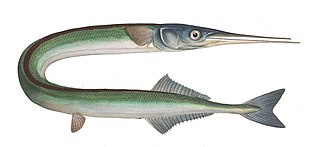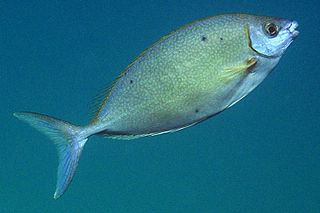Related Research Articles

The garfish, also known as the garpike or sea needle, is a pelagic, oceanodromous needlefish found in brackish and marine waters of the Atlantic Ocean and the Mediterranean, Caribbean, Black, and Baltic Seas.

Rabbitfishes or spinefoots are perciform fishes in the family Siganidae. The 29 species are in a single genus, Siganus. In some now obsolete classifications, the species having prominent face stripes—colloquially called foxfaces–are in the genus Lo. Other species, such as the masked spinefoot, show a reduced form of the stripe pattern. Rabbitfishes are native to shallow waters in the Indo-Pacific, but S. luridus and S. rivulatus have become established in the eastern Mediterranean via Lessepsian migration. They are commercially important food fish, and can be used in the preparation of dishes such as bagoong.

Snipe eels are a family, Nemichthyidae, of eels that consists of nine species in three genera. They are pelagic fishes, found in every ocean, mostly at depths of 300–600 m (980–1,970 ft) but sometimes as deep as 4,000 m (13,000 ft). Depending on the species, adults may reach 1–2 m (39–79 in) in length, yet they weigh only 80–400 g (2.8–14.1 oz). They are distinguished by their very slender jaws that separate toward the tips as the upper jaw curves upward. The jaws appear similar to the beak of the bird called the snipe. Snipe eels are oviparous, and the juveniles, called Leptocephali, do not resemble the adults but have oval, leaf-shaped and transparent bodies. Different species of snipe eel have different shapes, sizes and colors. The similarly named bobtail snipe eel is actually in a different family and represented by two species, the black Cyema atrum and the bright red Neocyema erythrosoma.

The yellow goatfish, also known as yellowsaddle, is a species of goatfish native to the Atlantic Ocean around the coasts of Africa and the Americas. This species can reach a total length of 39.4 cm (15.5 in), but most reach lengths only around 28 cm (11 in). They are of minor importance to local commercial fisheries, though they have been reported to carry the ciguatera toxin.

Sarpa salpa, known commonly as the dreamfish, salema, salema porgy, cow bream or goldline, is a species of sea bream, recognisable by the golden stripes that run down the length of its body, and which can cause ichthyoallyeinotoxism when eaten. It is found in the East Atlantic, where it ranges from the Bay of Biscay to South Africa, as well as in the Mediterranean. It has occasionally been found as far north as Great Britain. It is generally common and found from near the surface to a depth of 70 m (230 ft). Males are typically 15 to 30 cm (6–12 in) in length, while females are usually 31 to 45 cm (12–18 in). The maximum size is 51 cm (20 in).

An anchovy is a small, common forage fish of the family Engraulidae. Most species are found in marine waters, but several will enter brackish water, and some in South America are restricted to fresh water.

Fish are very diverse animals and can be categorised in many ways. Although most fish species have probably been discovered and described, about 250 new ones are still discovered every year. According to FishBase about 34,800 species of fish had been described as of February 2022, which is more than the combined total of all other vertebrate species: mammals, amphibians, reptiles and birds.

Several species of fish are claimed to produce hallucinogenic effects when consumed. For example, Sarpa salpa, a species of sea bream, is commonly claimed to be hallucinogenic. These widely distributed coastal fish are normally found in the Mediterranean and around Spain, and along the west and south coasts of Africa. Occasionally they are found in British waters. They may induce hallucinogenic effects similar to LSD if eaten. However, based on the reports of exposure they are more likely to resemble hallucinogenic effects of deliriants than the effects of serotonergic psychedelics such as LSD. In 2006, two men who apparently ate the fish experienced hallucinations lasting for several days. The likelihood of hallucinations depends on the season. Sarpa salpa is known as "the fish that makes dreams" in Arabic.
Awaous guamensis is a species of goby native to the Pacific islands from the Marianas to Vanuatu, New Caledonia and Fiji where it can be found in fresh, brackish and marine waters. Recent work based upon morphological and genetic differences has recognized Hawaiian populations of Awaous as being distinct from Awaous guamensis. Consequently, Hawaiian Awaous are now recognized as a distinct species Awaous stamineus.

The streamlined spinefoot, also known as the forktail rabbitfish, schooling rabbitfish or silver spinefoot, is a species of marine ray-finned fish, a rabbitfish belonging to the family Siganidae. It is found in the Indo-Pacific region.

Kyphosus is a genus of sea chubs native to the Atlantic, Indian and Pacific oceans. It is the only genus in the subfamily Kyphosinae of the family Kyphosidae.

Poisonous fish are fish that are poisonous to eat. They contain toxins which are not destroyed by the digestive systems of animals that eat the fish. Venomous fish also contain toxins, but do not necessarily cause poisoning if they are eaten, since the digestive system often destroys their venom.

Kyphosus elegans, the Cortez sea chub or Cortez chub, is a species of marine ray-finned fish, a sea chub from the family Kyphosidae. It is found in the eastern Pacific Ocean where it is of minor importance to commercial fisheries.

Kyphosus vaigiensis, the brassy chub, brassy drummer, long-finned drummer, low-finned drummer, Northern silver drummer, Queensland drummer, Southern drummer, blue-bronze sea chub, brassy rudderfish, yellow seachub, large-tailed drummer, low-finned chub or long-finned rudderfish, is a species of marine ray-finned fish, a sea chub from the family Kyphosidae. It is a largely herbivorous species which has a circumglobal distribution. Studies in the 21st Century appear to have shown that some other species in the genus Kyphosus are junior synonyms of this taxon.

Kyphosus cinerascens is a species of marine ray-finned fish. It is a sea chub from the family Kyphosidae. Kyphosus Cinerascens has 11 dorsal fins and 12 anal fins. Kyphosus cinerascens are widely distributed in the Indo-Pacific region. The Kyphosus cinerascens has a strict diet on phaeophytes, chlorophytes, and rhodophytes, making them herbivores.

Siganus fuscescens, the mottled spinefoot, black rabbitfish, black spinefoot, dusky rabbitfish, fuscous rabbitfish, happy moments, mi mi, pearl-spotted spinefoot, pin-spotted spinefoot, stinging bream or West Australian rabbitfish, is a species of marine ray-finned fish, a rabbitfish belonging to the family Siganidae. It is found in the Western Pacific Ocean.

Siganus spinus, the little spinefoot, scribbled rabbitfish, blunt-nosed spinefoot, spiny rabbitfish, or spiny spinefoot, is a species of marine ray-finned fish, a rabbitfish belonging to the family Siganidae. It is found in the Indo-Pacific region.

The Hawaiian chub, also known as the insular rudderfish or bicolor chub, is a species of marine ray-finned fish, a sea chub belonging to the family Kyphosidae. This species is found in the Central Pacific Ocean.
References
- ↑ Orsolini, Laura; Ciccarese, Michela; Papanti, Duccio; Berardis, Domenico De; Guirguis, Amira; Corkery, John M.; Schifano, Fabrizio (2021-06-02). "Psychedelic Fauna for Psychonaut Hunters: A Mini-Review". Frontiers in Psychiatry. 9: 153. doi: 10.3389/fpsyt.2018.00153 . PMC 5992390 . PMID 29910745.
- ↑ Sarpa Salpa Mahalo
- ↑ Froese, Rainer; Pauly, Daniel (eds.) (2009). "Sarpa salpa" in FishBase . October 2009 version.
- ↑ de Haro, L.; Pommier, P. (2006). "Hallucinatory fish poisoning (ichthyoallyeinotoxism): two case reports from the Western Mediterranean and literature review". Clinical Toxicology. 44 (2): 185–8. doi:10.1080/15563650500514590. PMID 16615678. S2CID 41191477.
- ↑ Clarke, Matt (2006-04-19). "Men hallucinate after eating fish". Practical Fishkeeping. Archived from the original on 2011-06-05. Retrieved 2010-03-31.
- ↑ Froese, Rainer; Pauly, Daniel (eds.) (2009). "Siganus spinus" in FishBase . October 2009 version.
- ↑ Froese, Rainer; Pauly, Daniel (eds.) (2009). "Mulloidichthys samoensis" in FishBase . October 2009 version.
- ↑ Thomas, Craig, M.D. and, Susan Scott (Jun 1, 1997). All Stings Considered: First Aid and Medical Treatment of Hawai'i's Marine Injuries. Hawaii: University of Hawai'i Press. p. 120. ISBN 9780824819002.
{{cite book}}: CS1 maint: multiple names: authors list (link)